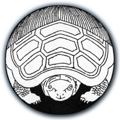Halving the Bones
read an excerpt
Fade up on TITLES: HALVING THE BONES INT. RUTH'S APARTMENT
Ruth is sitting at a desk in the corner of the room, typing at a computer. Over the clicking of the keys, we can hear the faint strains of Hawaiian slack-key guitar, and then the voice of MATSUYE, the Japanese woman narrator.
MATSUYE (Voice Over) Kanojo wa Rusu. Ha-fu desu. Hanbun wa nihonjin de, hanbun wa Americajin..... This is Ruth. She is half. That means half-Japanese and half-American. Five years after her Japanese grandmother died, she still had her bones in an old tea can, sitting in a closet, in her apartment in New York. That is the beginning of this story.
Ruth has moved to the floor and is dragging out an old cardboard box, marked "Fragile." She opens it. Lying on top is a large Japanese doll. She digs underneath, looking through the contents.
MATSUYE (V.O. cont) Ruth had brought the bones back from Japan to give to her mother. Her mother could not go to the grandmother's funeral. It was bad timing. So Ruth went instead. The Japanese relatives thought that having some bones would be a nice consolation for the mother. So they had performed "hone wake," the "dividing of the bones."
Ruth pulls out an envelope that says, "Snapshot Memories." She flips through photographs from the 1920's of a young Japanese man, dressed in a suit and a hat, standing next to a stalk of sugarcane that towers over his head.
MATSUYE (V.O. cont.) In Japan, when a body is cremated, it is not reduced to ash, as in America, but just to the bones. After the grandmother's cremation, they made a careful selection. With a pair of wooden chopsticks, they chose a bit of rib and a fragment of skull and another piece, too. Then they wrapped the three bones in the grandmother's fancy handkerchief for the trip back to her daughter in America.
Ruth pulls out an old passport. Inside is a picture of two young Japanese children, and another of a young Japanese woman in kimono. Above the photographs, in ornate italic script, are printed the words, "Imperial Japanese Government Passport."
MATSUYE (V.O. cont.) Ruth had brought the bones of her grandmother back to New York, but she never delivered them to her mother. The bones sat on various shelves, and in packing boxes, during three moves and her divorce. Her mother never asked her about them. Now, Ruth has decided that something must be done about the bones. The idea of her grandmother, fragmented and ignored, has begun to bother her.
Ruth looks quizzically up from the passport that she is studying, and she smiles.
CUT TO:
A grainy, black and white image of a Japanese infant's face, upside down. Slowly, as the camera clocks, the baby's face starts to rotate.
RUTH (V.O.) My name is Ruth, but I don't like it. It's not a good name for a young person.

